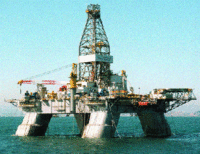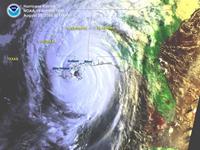-
Carbon capture and storage likely to cause earthquakes
Carbon capture and storage, or CCS, is a major component of the world’s greenhouse gas reduction strategy; to make a significant contribution to emission reduction, however, CCS would need to operate on a massive scale, potentially sequestering upward of 3.5 billion metric tons of CO2 each year; researchers say that the injection of massive quantities of CO2 would be likely to induce small temblors which would break the reservoirs’ seals and release the stored CO2 into the atmosphere
-
-
Exploring the Bermuda Triangle's swirling vortices

Researchers, funded by the Office of Naval Research, deployed twenty-one underwater probes to study vortices at the Bermuda Triangle; a vortex is a swirl of water that can be created in several ways, including water being pushed between land masses and then released into the open ocean; the oceanographers did well to lose only one of the underwater probes, considering they were studying the notorious Triangle
-
-
For safer offshore drilling, government should modify monitoring practices

Since the April 2010 Deepwater Horizon blowout and explosion, the federal government as well as the offshore oil and gas industry have been undergoing major changes, including the issuance of regulations requiring operators of offshore facilities to adopt and implement comprehensive Safety and Environmental Management System (SEMS) programs by 15 November 2011
-
-
Nuclear waste repositories in suburbia?
Finding sites for nuclear waste storage is a growing problem, with decision makers running into the “not in my back yard” problem; the demise of Nevada’s Yucca Mountain project is but the latest example; researchers find that acceptance of sites for spent nuclear fuel repository may well depend on gender and economic background: in Finland, at least, affluent men more often are more receptive to the idea of locating such facilities near their neighborhoods than women or disadvantaged people
-
-
Explaining extreme months
Two months in Midwest history — March 2012 and December 1889 — stand out as the warmest winter months in more than a century of weather records; scientists investigated why these months, separated by 123 years, were so exceptional
-
-
Laser beams shine light on nature’s extreme events

“Extreme” events in nature, such as hurricanes, tsunamis and bushfires, may be more commonplace and predictable than you might think; researchers are using lasers to study how frequently extreme events happen, and their work highlights that in nature, “extreme” does not have to mean “rare”
-
-
Fire risks to increase in some regions of the world
Climate change is expected to disrupt future fire patterns around the world, with some regions, such as the western United States, seeing more frequent fires within the next thirty years; at the same time, fire activity could actually decrease around equatorial regions, particularly among the tropical rainforests, because of increased rainfall
-
-
Downstream consequences of depleting groundwater
Many jurisdictions across the united States manage and regulate surface water and groundwater without any recognition of the connections between the two; for instance, California has no legal framework for comprehensively managing the impacts of groundwater pumping; across most of California, well owners can pump as much as they like with little accountability for the impacts on rivers, other water users and ecosystems
-
-
Floating dock from Japan carries potential invasive species
When debris from the 2011 earthquake and tsunami in Japan began making its way toward the West Coast of the United States, there were fears of possible radiation and chemical contamination as well as costly cleanup; a floating dock that unexpectedly washed ashore in Newport, Oregon, earlier this month, and which has been traced back to the Japanese disaster, has brought with it a completely different threat — invasive species
-
-
Nuclear, coal-fired electrical plants vulnerable to climate change
Thermoelectric plants, which use nuclear or fossil fuels to heat water into steam that turns a turbine, supply more than 90 percent of U.S. electricity and account for 40 percent of the U.S. freshwater usage; in Europe, these plants supply three-quarters of the electricity and account for about half of the freshwater use; warmer water and reduced river flows in the United States and Europe in recent years have led to reduced production, or temporary shutdown, of several thermoelectric power plants; a new study says this problem will only grow
-
-
Geoengineering may lead to whiter sky
One idea for fighting global warming is to increase the amount of aerosols in the atmosphere, scattering incoming solar energy away from the Earth’s surface; scientists, however, theorize that this solar geoengineering could have a side effect of whitening the sky during the day
-
-
Groundwater depletion in Texas, California threatens US food security
The U.S. food supply may be vulnerable to rapid groundwater depletion from irrigated agriculture; for example, from 2006 to 2009, farmers in the south of California’s Central Valley depleted enough groundwater to fill the U.S. largest man-made reservoir, Lake Mead near Las Vegas — a level of groundwater depletion that is unsustainable at current recharge rates
-
-
Removing CO2 from the flues of coal-fired power plants
The current method of removing the greenhouse gas carbon dioxide (CO2) from the flues of coal-fired power plants uses so much energy that no one bothers to use it; scientists have developed an entirely new catalyst for separating out and capturing CO2, one that mimics a naturally occurring catalyst operating in our lungs
-
-
Explaining uneven rise in sea levels
If there is a global warming trend, one of its consequences would a rise in sea levels, which will require massive mitigation efforts to protect coastal infrastructure; rather than a uniform rise in sea level, however, the records show sea levels rising in some areas and dropping in others; Harvard researchers offer an explanation for this phenomenon
-
-
Solving southwest U.S. water shortage by water cap and trade?
Lake Mead, on the Colorado River, is the largest reservoir in the United States, but users are consuming more water than flows down the river in an average year, which threatens the water supply for agriculture and households; researchers suggest that to solve this imbalance, a water cap-and-trade system, successfully implemented in Australia, should be considered for interstate water trading
-
- All
- Regional
- Water
- Biometrics
- Borders/Immig
- Business
- Cybersecurity
- Detection
- Disasters
- Government
- Infrastructure
- International
- Public health
- Public Safety
- Communication interoperabillity
- Emergency services
- Emergency medical services
- Fire
- First response
- IEDs
- Law Enforcement
- Law Enforcement Technology
- Military technology
- Nonlethal weapons
- Nuclear weapons
- Personal protection equipment
- Police
- Notification /alert systems
- Situational awareness
- Weapons systems
- Sci-Tech
- Sector Reports
- Surveillance
- Transportation
Advertising & Marketing: advertise@newswirepubs.com
Editorial: editor@newswirepubs.com
General: info@newswirepubs.com
2010-2011 © News Wire Publications, LLC News Wire Publications, LLC
220 Old Country Road | Suite 200 | Mineola | New York | 11501
Permissions and Policies
Editorial: editor@newswirepubs.com
General: info@newswirepubs.com
2010-2011 © News Wire Publications, LLC News Wire Publications, LLC
220 Old Country Road | Suite 200 | Mineola | New York | 11501
Permissions and Policies
